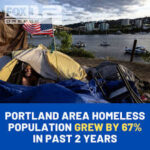Homelessness in Multnomah County Sees Sharp Increase
PORTLAND, Ore. — The latest 2025 report from Portland State University’s Homelessness Research & Action Collaborative (HRAC) reveals that homelessness in the Portland metro area has grown significantly over the past two years. The report found a 67% increase in Multnomah County since 2023, reflecting a broader 61% rise across the tri-county region of Clackamas, Multnomah, and Washington counties.
The data, released as part of the annual Point-in-Time (PIT) Count, paints a troubling picture of housing insecurity in the Portland area, while also noting that improved counting methods and outreach efforts likely contributed to higher reported numbers.
What Is the Point-in-Time Count?
The Point-in-Time Count, conducted on the night of January 22, 2025, provides a one-night snapshot of how many people are experiencing homelessness across the region. Required by the U.S. Department of Housing and Urban Development (HUD), this survey helps determine funding levels and policy direction for housing and homeless services.
Also Read
While essential, the PIT Count has known limitations. Because it captures only one night, it may undercount individuals who are “doubled up” with family or friends or living in places that are difficult for outreach workers to access.
Regional and County-by-County Breakdown
Across the three counties, the 2025 PIT Count found 12,034 people experiencing homelessness, up from 7,483 in 2023—an overall 61% increase.
-
Multnomah County: 67% increase (from roughly 6,300 to over 10,500 individuals)
-
Clackamas County: 39% increase (from around 411 to nearly 570)
-
Washington County: 22% increase (from about 772 to approximately 940)
This coordinated approach marks the second “fully integrated tri-county” effort, meaning all three counties used shared data systems, survey tools, and administrative coordination to ensure consistency across the region.
Why the Numbers Rose
Researchers at PSU emphasized that not all of the increase necessarily represents a true surge in homelessness. Part of the change reflects improved data collection and expanded outreach. For example, Multnomah County added new administrative data sources to identify unsheltered individuals, allowing for a more comprehensive count.
However, the report also highlights real-world trends contributing to the rise, including:
-
Increased eviction filings — up 33% in Multnomah County and 63% in Washington County between 2023 and 2024.
-
Persistent housing affordability crisis — with rental costs and home prices continuing to outpace income growth.
-
Economic instability and loss of pandemic-era housing supports, leaving more residents vulnerable to displacement.
Measured Change vs. Real Change
The PSU report draws a critical distinction between “measured change” (the difference in reported numbers) and “real change” (the actual growth of the homeless population).
While improved methods may have revealed previously uncounted individuals, PSU researchers caution that the underlying economic pressures—especially rising rents, higher eviction rates, and limited access to affordable housing—are contributing to genuine increases.
In other words, the growth in homelessness is both a product of better visibility and worsening economic conditions.
Broader Implications for Portland and Surrounding Areas
Local leaders say the findings underscore the urgency of expanding shelter capacity, supportive housing, and mental health services. Despite recent investments in affordable housing projects and emergency shelters, the demand continues to outstrip supply.
The Portland Housing Bureau and Multnomah County Joint Office of Homeless Services have already begun reviewing the data to identify priority areas for resource deployment. Officials note that the count helps guide federal and state funding decisions and refine regional strategies.
Meanwhile, residents across the metro area continue to express concern about the visible impacts of homelessness, including public safety and livability issues. Advocacy groups, however, stress that long-term solutions must center on affordable housing access, not short-term enforcement actions.
Bottom Line
While better data collection and expanded outreach likely inflated the numbers compared to prior years, the 2025 Point-in-Time Count makes clear that homelessness remains a critical and growing challenge for Portland and its neighboring counties.
The combination of rising eviction rates, limited affordable housing, and economic instability continues to push more people into crisis.
As PSU researchers summarized, the findings should serve as both a wake-up call and a guidepost—reminding policymakers that behind every statistic are real people struggling to find stability in a region where housing costs continue to climb faster than wages.












